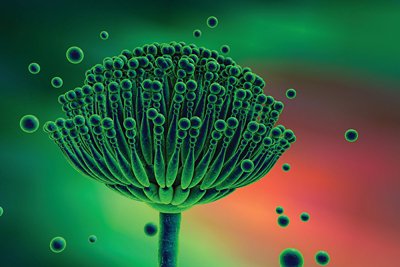Aspergillus brasiliensis
How It Contaminates Humans
by Felix MONTERO-JULIAN PhD — February 21, 2020

WHAT IS ASPERGILLUS BRASILIENSIS ?
Aspergillus brasiliensis is a fungus and is one of the most common species of the genus Aspergillus. It is ubiquitous in soil, a common food contaminant, and is also regularly reported from indoor environments such as industrial plants. Human disease caused by Aspergillus brasiliensis is rare compared to other Aspergillus species. However, when it is caused it can result in a serious lung condition called aspergillosis.
This article gives an overview of :
● The transfer of Aspergillus brasiliensis
● The detection, prevention and control of the Aspergillus brasiliensis fungus
● The risks of Aspergillus brasiliensis for consumers
● Treating Aspergillus brasiliensis
● Overview of industries affected by Aspergillus brasiliensis
● bioMérieux’s products and solutions for detecting and preventing Aspergillus brasiliensis
PREVENTION, DETECTION AND TREATMENT
How is Aspergillus brasiliensis transferred?
As a fungal contaminant Aspergillus brasiliensis is transmitted through interaction with spores. The spores can be spread in hospitals and manufacturing facilities via the hands of healthcare workers, or through the use of equipment that isn’t properly cleaned. Aspergillus brasiliensis infections are considered opportunistic, meaning the organism only causes disease when a person's immune system is already impaired.
How can Aspergillus brasiliensis be prevented and controlled in the pharmaceutical industry?
Aspergillus brasiliensis can be prevented and controlled in drug manufacturing facilities through the establishment of facility and process controls that prevent microbiological contamination. Most vegetative bacteria and fungi will succumb to broad spectrum disinfectants and cleaning practices should be developed in line with industry control guidelines. A comprehensive cleaning program should involve ensuring adequate quality of incoming materials, sanitary design, production and storage time limitations, and monitoring of environmental conditions.
How can the presence of Aspergillus brasiliensis be detected and controlled in the pharmaceutical industry?
Aspergillus brasiliensis can be detected using media such as Sabouraud Dextrose Agar (SDA). It is recommended that tissue and fluid specimens be submitted in adequate quantities for simultaneous histopathologic/cytologic and culture examination. Alternative microbiological methods, including automated methods that may involve Aspergillus brasiliensis gram stain may be used, provided that their equivalence to the pharmacopoeia method has been demonstrated.
What are the risks of Aspergillus brasiliensis to the consumer?
Healthy people are usually at low risk of infection of Aspergillus brasiliensis. Those who already have a weakened immune system, due to another illness or condition, or have been hospitalized for an extended period of time, are at a higher risk of infection. Infected patients can develop a severe condition known as aspergillosis which can take the form of invasive pulmonary aspergillosis, Aspergillus sinusitis, disseminated aspergillosis, and/or one of several forms of single-organ invasive aspergillosis.
What is the treatment for Aspergillus brasiliensis contamination?
When a case of aspergillosis is confirmed, patients are treated with medicines that incorporate anti-fungal molecules, such as voriconazole and Amphotericin B1.
KEY FIGURES AND ELEMENTS
● Aspergillus genus is responsible for around 75% cases of otomycosis (an infection of the external auditory canal and auricle), and brasiliensis is the most common cause.
● Aspergillus brasiliensis is an opportunistic pathogen - it becomes pathogenic when the first line of defense is broken.
● Aspergillus brasiliensis is used in industry for enzymes and metabolites production.
What common industries are affected by Aspergillus brasiliensis?
Aspergillus brasiliensis affects the following industries:
● Non-sterile Pharma and Personal Care
● Medical Device Systems
● Advanced and Cellular Therapies
1 Patterson, Thomas F. et coll., (2016) Practice Guidelines for the Diagnosis and Management of Aspergillosis, Clinical Infectious Diseases, 63, 15 August, 1-60.
BIOMÉRIEUX SOLUTIONS
CULTURE MEDIA
Culture can be used for cells and microorganisms sample growth in laboratories. Reliable culture media solutions are an important part of microbiology testing, safeguarding pharmaceutical products from contamination whilst helping to protect patients and contributing to public health in general.
BIOBALL® Standardized Strains
BIOBALL was developed as a water soluble solution for growth promotion testing, sterility assurance testing and antimicrobial effectiveness testing. They come with a variety of adaptable solutions that enhance pathogen detection speed and accuracy.
IDENTIFICATION
Our pathogen identification range includes solutions such as API®, VITEK® MS, VITEK® 2 COMPACT, and VITEK® EXPRESS which are rapid identification methods. Thank to state of the art technology, precise results can be achieved in minutes.
DETECTION
SCANRDI® and BACTALERT® are pathogen detection solutions for the pharmaceutical industry. They greatly increase the operational efficiency, both for faster release and in-process control purposes, from raw material to finished product. Above all, this contributes increasing patient safety by getting an early access to the therapy
